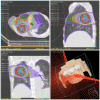Flattening filter-free technique in volumetric modulated arc therapy for lung stereotactic body radiotherapy: A clinical comparison with the flattening filter technique
- PMID: 29563993
- PMCID: PMC5854932
- DOI: 10.3892/ol.2018.7809
Flattening filter-free technique in volumetric modulated arc therapy for lung stereotactic body radiotherapy: A clinical comparison with the flattening filter technique
Abstract
The present study sought to evaluate the impact of the flattening filter-free (FFF) technique in volumetric modulated arc therapy for lung stereotactic body radiotherapy. Its clinical safety and availability were compared with the flattening filter (FF) method. The cases of 65 patients who underwent lung volumetric modulated arc therapy-stereotactic body radiotherapy (VMAT-SBRT) using FF or FFF techniques were reviewed. A total of 55 Gy/4 fractions (fr) was prescribed for peripheral lesions or 56 Gy/7 fr for central lesions. The total monitor units (MU), treatment time, dose to tumors, dose to organs at risk, tumor control (local control rate, overall survival, progression-free survival) and adverse events between cases treated with FF and cases treated with the FFF technique were compared. A total of 35 patients were treated with conventional FF techniques prior to November 2014 and 30 patients were treated with FFF techniques after this date. It was revealed that the beam-on time was significantly shortened by the FFF technique (P<0.01). Other factors were similar for FFF and FF plans in respect to conformity (P=0.95), homogeneity (P=0.20) and other dosimetric values, including total MU and planning target volume/internal target volume coverage. The median follow-up period was 18 months (range, 2-35). One-year local control rates were 97.1 and 90.0% in the FF group and FFF groups, respectively (P=0.33). Grade 3 pneumonitis was observed in 5.8% of FF patients and 3.4% of FFF patients (P=1.00). No other adverse events ≥grade 3 were observed. The results of the study suggest that VMAT-SBRT using the FFF technique shortens the treatment time for lung SBRT while maintaining a high local control rate with low toxicity.
Keywords: flattening filter-free; lung cancer; radiation pneumonitis; stereotactic body radiotherapy; volumetric modulated arc therapy.
Figures







Similar articles
-
Single-fraction flattening filter-free volumetric modulated arc therapy for lung cancer: Dosimetric results and comparison with flattened beams technique.Med Dosim. 2016 Winter;41(4):334-338. doi: 10.1016/j.meddos.2016.09.002. Epub 2016 Oct 15. Med Dosim. 2016. PMID: 27751617
-
Role of Volumetric-Modulated Arc Therapy with Flattening Filter Free Delivery in Lung Stereotactic Body Radiotherapy.J Med Imaging Radiat Sci. 2016 Jun;47(2):155-159. doi: 10.1016/j.jmir.2016.04.004. Epub 2016 May 7. J Med Imaging Radiat Sci. 2016. PMID: 31047179
-
Evaluation of flattening-filter-free and flattening filter dosimetric and radiobiological criteria for lung SBRT: A volume-based analysis.Front Oncol. 2023 Jan 24;13:1108142. doi: 10.3389/fonc.2023.1108142. eCollection 2023. Front Oncol. 2023. PMID: 36761961 Free PMC article.
-
FFF-VMAT for SBRT of lung lesions: Improves dose coverage at tumor-lung interface compared to flattened beams.J Appl Clin Med Phys. 2020 Jan;21(1):26-35. doi: 10.1002/acm2.12764. Epub 2019 Dec 20. J Appl Clin Med Phys. 2020. PMID: 31859456 Free PMC article.
-
Progress and prospects of flattening filter free beam technology in radiosurgery and stereotactic body radiotherapy.Crit Rev Oncol Hematol. 2021 Jul;163:103396. doi: 10.1016/j.critrevonc.2021.103396. Epub 2021 Jun 17. Crit Rev Oncol Hematol. 2021. PMID: 34146680 Review.
Cited by
-
Flattening filter free stereotactic body radiation therapy for lung tumors: outcomes and predictive factors.Transl Cancer Res. 2021 Feb;10(2):571-580. doi: 10.21037/tcr-20-3174. Transl Cancer Res. 2021. PMID: 35116391 Free PMC article.
-
Surface and build-up dose comparison between Elekta 6 MV flattening filter and flattening-filter-free beams using an advanced Markus ionization chamber and a solid water-equivalent phantom.J Appl Clin Med Phys. 2020 Dec;21(12):334-339. doi: 10.1002/acm2.13094. Epub 2020 Nov 12. J Appl Clin Med Phys. 2020. PMID: 33184970 Free PMC article.
-
Dosimetric verification of annual quality assurance for a linear accelerator using a transmission type detector.Sci Rep. 2023 Oct 21;13(1):17994. doi: 10.1038/s41598-023-45114-2. Sci Rep. 2023. PMID: 37865666 Free PMC article.
-
Salvage stereotactic body radiotherapy for post-operative oligo-recurrence of non-small cell lung cancer: A single-institution analysis of 59 patients.Oncol Lett. 2020 Apr;19(4):2695-2704. doi: 10.3892/ol.2020.11407. Epub 2020 Feb 17. Oncol Lett. 2020. PMID: 32218820 Free PMC article.
-
Development of physical technology plays an important role in reducing radiation-induced lung injury.Chin Med J (Engl). 2025 Feb 5;138(3):349-351. doi: 10.1097/CM9.0000000000003418. Epub 2024 Dec 17. Chin Med J (Engl). 2025. PMID: 39682013 Free PMC article. No abstract available.
References
-
- Nanda RH, Liu Y, Gillespie TW, Mikell JL, Ramalingam SS, Fernandez FG, Curran WJ, Lipscomb J, Higgins KA. Stereotactic body radiation therapy versus no treatment for early stage non-small cell lung cancer in medically inoperable elderly patients: A National Cancer Data Base analysis. Cancer. 2015;121:4222–4230. doi: 10.1002/cncr.29640. - DOI - PubMed
-
- Nagata Y, Hiraoka M, Shibata T, Onishi H, Kokubo M, Karasawa K, Shioyama Y, Onimaru R, Kozuka T, Kunieda E, et al. Prospective trial of stereotactic body radiation therapy for both operable and inoperable T1N0M0 non-small cell lung cancer: Japan Clinical Oncology Group Study JCOG0403. Int J Radiat Oncol Biol Phys. 2015;93:989–996. doi: 10.1016/j.ijrobp.2015.07.2278. - DOI - PubMed
LinkOut - more resources
Full Text Sources
Other Literature Sources
Research Materials
